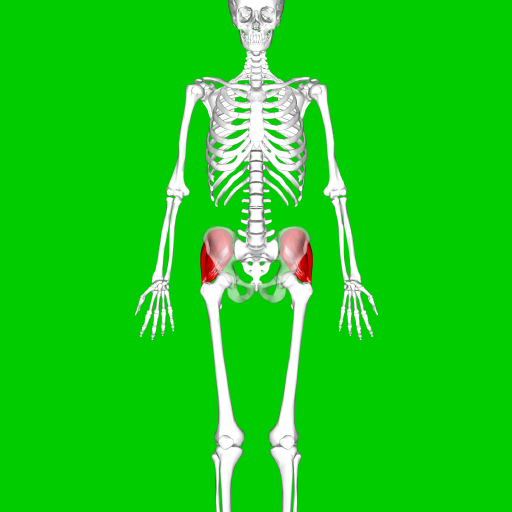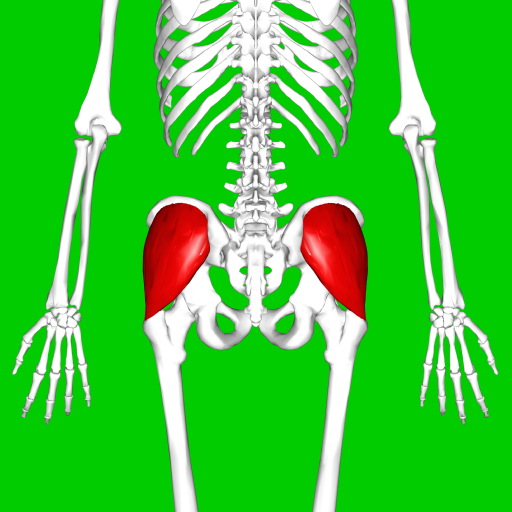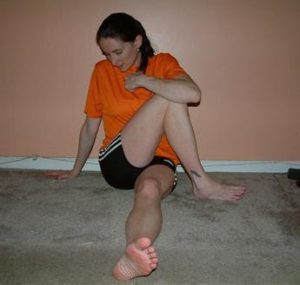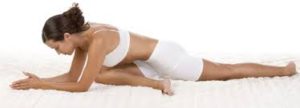Writers and back pain. They seem to go together.
Could be because we sit a lot, often without the proper ergonomic setup, and maybe without a very good cushion or chair. Even if we have premier office equipment, we’re on our backsides way too much, which is a sure prescription for back pain.
Why would sitting hurt our backs? There are a lot of reasons, one of them being that we’re putting a lot of pressure on the spine. (That’s why I recommend writers and other office workers use a cocci cushion when working—read more here.)
But there’s another very specific reason that sitting for hours results in chronic low back pain: it results in a weak backside.
You may have never thought about it before, but if you want to be a healthy writer (or computer programmer or office worker or anyone else at a desk for long periods of time), you have to pay attention to your booty.
Ready to look behind you?
Weak Butt Muscles Can Cause Chronic Low Back Pain
You’ve probably heard—sitting is the new smoking. (Read more about that here.) What you may not have heard is that It’s also horrible for our butt muscles.
A 2014 study reported that sitting too long actually expands our backsides, and can also promote obesity. Study author Amit Gefen, professor at Tel Aviv University’s Department of Biomedical Engineering, also noted his previous research showed sitting not only allowed fat cells to grow, but caused muscle cells to disappear.
And that spells problems for the back. As we sit and sit and our glute muscles get weak, they are less able to support the spine, which can lead to chronic low back pain.
Researchers from the University of Iowa recently reported on how weak glute muscles, in particular, can result in back problems. They selected 150 adults with chronic low back pain and 75 matched controls, and then put them through a thorough examination. Doctors tested their backs, the strength in their gluteus maximus muscles, and the function of their hip abductors, among other things.
They found that overall, people with chronic low back pain had weaker “gluteus medius” muscles than those who didn’t suffer from chronic lower back pain. Even more interesting: on the side where the participants were experiencing pain, the muscle there was weaker even than the same muscle on the other side. These muscles were also more tender to the touch.
What is the Gluteus Medius?
The gluteus medius is one of three main muscles in the rear end, along with the more familiar gluteus maximus and the less known gluteal aponeurosis. To help you picture the location, here are a couple illustrations:

 You can also think of this muscle as your “hip abductor,” that muscle that helps you lift your leg straight out to the side.
You can also think of this muscle as your “hip abductor,” that muscle that helps you lift your leg straight out to the side.
Turns out that this trio of muscles does a lot for the spine. When they’re working correctly, they control movements in the torso, pelvis, hips and legs, keeping the body balanced and the spine supported.
If those muscles aren’t strong, though, the muscles in the lower back have to do more work to keep you upright, which means more strain and eventually, pain.
A Test to See if Your Gluteus Medius is Weak
How can you tell if your gluteus medius is weak?
The study authors noted in their research above that people with chronic low back pain who had weak gluteus muscles were also more likely to demonstrate the Trendelenburg Sign. This is a finding from a physical examination that is associated with hip abnormalities, including weak muscles.
If the glute muscles are weak, for instance, particularly the gluteus medius, it will be less able to support the body’s weight when you’re standing on one leg. You may actually lean the pelvis over to compensate for the weak muscle, or your pelvis may tilt down as you walk.
This can be kind of hard to picture, so take a look at this video. Here you can see how someone with a positive Trendelenburg Sign might appear. You can also try the test yourself to see how you respond.
Even if you can stand up straight with one leg lifted, you might try leaning like the man does in the test, and see if you experience tenderness or pain in the glute muscle. You may notice a twinge deep in your seat—that is your gluteus medius, and pain there indicates trouble.
Experts Know that Weak Glutes Go with Back Pain
Those who work with patients who suffer from back pain know all about how the gluteus muscles are involved. David Kent, LMT, NCTMB, writes in Massage Today:
“Each week, I treat several clients who complain of ‘low back pain.’ For many patients, however, the primary cause of their pain is not the lower back but the gluteus medius muscle.”
In a study currently underway by the Sport and Spine Rehab Clinical Research Foundation, the researchers acknowledge the connection between low back pain and weak glutes:
“Recent studies have shown the importance of the gluteal musculature in the treatment of low back pain. It was found that the gluteus maximus (Gmax) is significantly more active in a low back pain population compared to a healthy population, indicating the low back pain population relied on the Gmax to fire more to overcome the gluteal weakness.”
Personal trainer Ryan Starnes says he frequently finds weak gluteus medius muscles in his patients with chronic low back pain:
“The gluteus medius muscle is a primary stabilizer of the hip and when weak has been found to correlate with low back pain, hip pain, and knee pain. I frequently find that the gluteus medius muscle is weak in clients, irrespective of age, and aim to strengthen it along with the gluteus maximus.”
Chiropractor Dr. David Marcon goes even further, to say that a weak, tight gluteus medius can cause not only low back pain, but a dysfunctional gait that can eventually lead to hip pain, knee pain, foot and ankle pain, shin pain, plantar fasciitis, Achilles tendon pain, and even a need for a knee or hip replacement!
“Spare yourself the agony and the expense by taking the time to stretch & strengthen the glute medius,” he says.
So how do we do that?
3 Ways to Strengthen Your Gluteus Medius
Fortunately, the exercises you can do to build up this muscle are not difficult, and you can complete a series of them in about five minutes. Make sure you always check with your doctor before performing any new exercises to avoid injury.
1-Hip external rotation: Lay on your side with your knees bent, legs together. Support your head in the crook of your elbow, and rest your outside hand on your hip. Keeping your feet pressed together side-by-side, lift the top leg, so you’re separating the legs sort of like a clip opening and closing. Make sure you’re using your glute muscles and not your back to make the movement.
Here’s an example:
2-Sidelying Abduction: This is similar to the exercise above, except this time you’re lifting the entire leg, rather than just part of it. It’s considered one of the best exercises you can do for the gluteus medius. Simply lie on your side, keeping your torso still, and lift your top leg toward the ceiling. Return to starting, and repeat 5-10 times. Switch legs and repeat on the other side. Make sure you’re engaging your glutes during the exercise, and don’t allow the rest of your body to move.
Here’s an example:
3-Lateral band walk: You’ll need an exercise band for this exercise. Put that band around your ankles, or around the balls of your feet. (Both examples shown below.). Then you just walk from one side to the other. As you step to the side, you should feel your gluteus medius working.
Here’s example #1:
Here’s example #2:
You can also use the hip abduction machine at the gym, if you have a membership.
3 Ways to Stretch Your Gluteus Medius
When you finish with your strengthening exercises, be sure to stretch the muscles you just worked. Tight muscles can make back pain worse.
 Sit down on the floor, and place one leg over the other leg. Gently apply pressure against the upper thigh/knee until you feel the stretch in the buttock. Hold the stretch for 10-15 seconds and repeat 3 times.
Sit down on the floor, and place one leg over the other leg. Gently apply pressure against the upper thigh/knee until you feel the stretch in the buttock. Hold the stretch for 10-15 seconds and repeat 3 times. Lay flat on your back. Cross one ankle over the other knee, and then pull the bottom leg toward you until you feel the stretch in your glutes. Hold for 10-15 seconds, and then repeat on the other side.
Lay flat on your back. Cross one ankle over the other knee, and then pull the bottom leg toward you until you feel the stretch in your glutes. Hold for 10-15 seconds, and then repeat on the other side. Start in a lunge position. Bring the bent leg under to lie flat against the floor, and gently ease your weight down. Your ankle should be flat against the floor, but you shouldn’t feel any knee strain. The pull should be in your glutes. Hold for 10-15 seconds and repeat on the other side.
Start in a lunge position. Bring the bent leg under to lie flat against the floor, and gently ease your weight down. Your ankle should be flat against the floor, but you shouldn’t feel any knee strain. The pull should be in your glutes. Hold for 10-15 seconds and repeat on the other side.
Do you think weak glutes could be contributing to your back pain? Please share your story, or any tips you may have.
Sources
Cooper NA, et al., “Prevalence of gluteus medius weakness in people with chronic low back pain compared to healthy controls,” Eur Spine J., May 26, 2015, http://www.ncbi.nlm.nih.gov/pubmed/26006705.
Naama Shoham, et al., “Adipocyte Stiffness Increases with Accumulation of Lipid Droplets,” Biophysical Journal, March 18, 2014; 106(6): 1421-1431, http://www.cell.com/biophysj/abstract/S0006-3495%2814%2900180-5?cc=y=.


I confess that, although I did these exercises when rehabbing after my disc surgery, I’ve neglected them after that. Matter of fact, I never connected my back pain with my prolonged hours at the computer. Thanks for the reminder.
It’s easy to neglect them once you start feeling better—I’ve done that too! Good luck in easing that pain. :O)
Great article!! I never associated a weak rear end with back pain, but I do know that when I do Pilates consistently my back never hurts. And Pilates definitely works the gluteus medius muscles! You included all of my very favorite leg stretches. For exercises that might help, I also do big and small circles with each leg after leg lifts (5 each direction on the big leg rotations, and 10 each direction on the small leg rotations). On the big rotations, the toe should draw an imaginary circle the size of the outside of a barrel. On the small rotations, the size of a watermelon. If that makes any sense!
Oh yeah, I used to do those when doing Pilates, too. Great recommendations. Thanks, Chere!